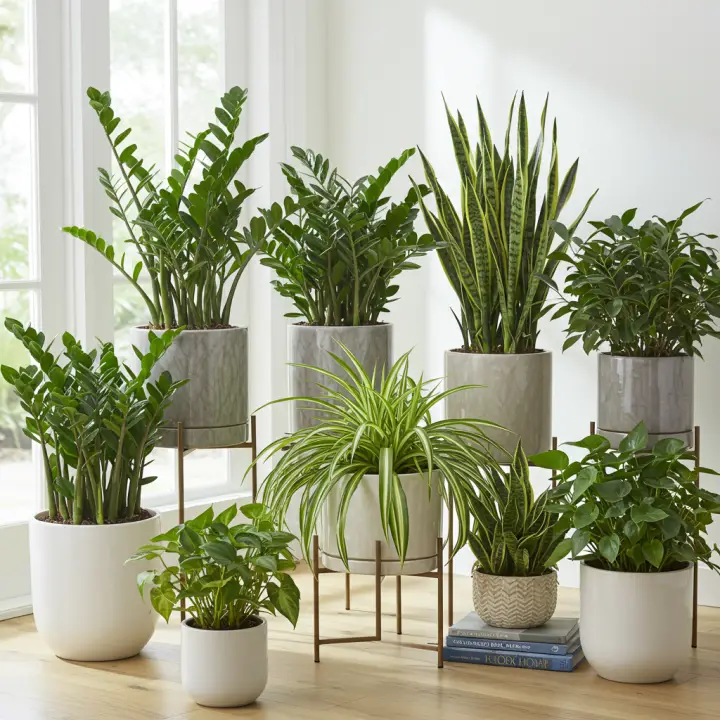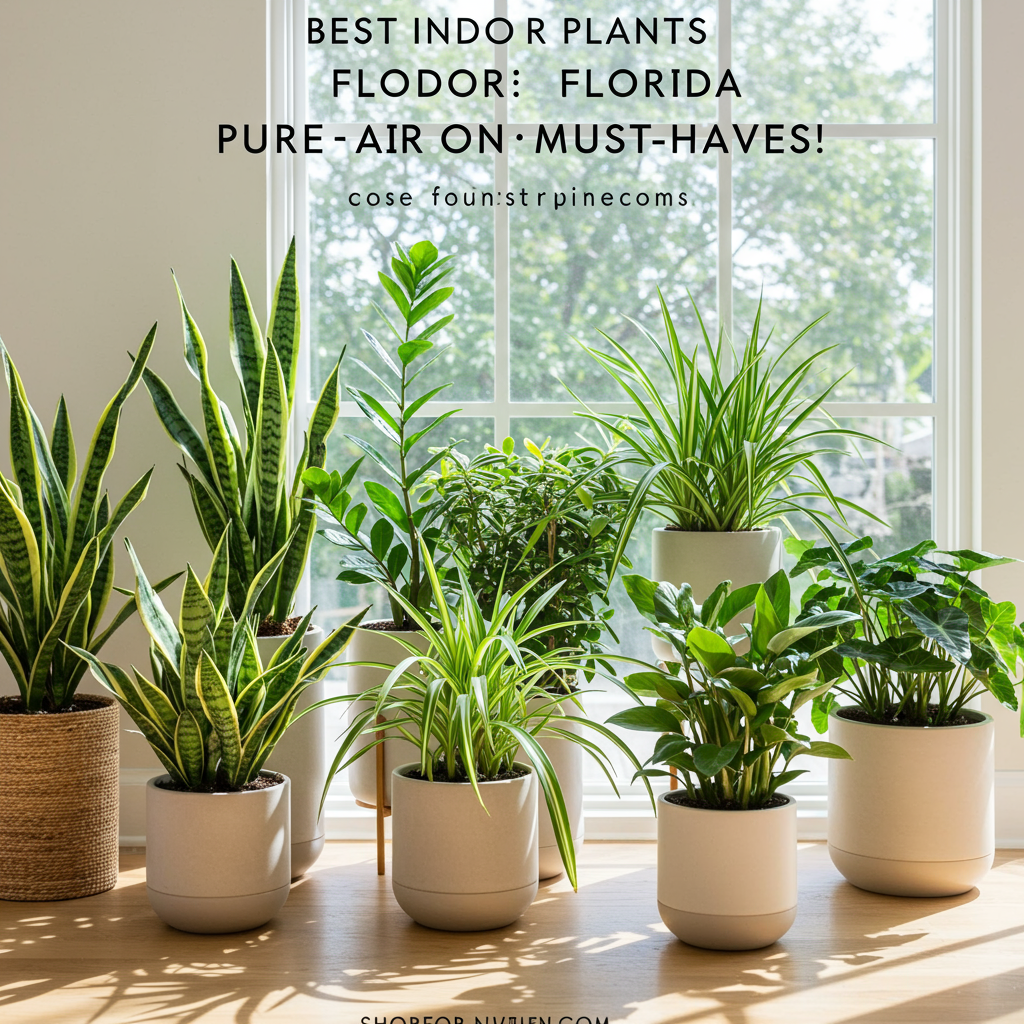Discover the best indoor plants for Florida homes that not only beautify your living space but also significantly improve air quality. Learn about easy-care, air-purifying varieties perfectly suited to the Sunshine State’s unique climate, transforming your home into a fresh, vibrant sanctuary.
Welcome to the heart of Florida, where the sun shines bright, and the air is often humid. While the outdoors boasts lush, tropical beauty, transforming your indoor space into a breathable oasis is equally rewarding. Choosing the right houseplants can not only elevate your home’s aesthetics but also act as natural air purifiers, combating common indoor pollutants. This guide will help you select the ideal green companions that flourish in Florida’s environment, ensuring your home is both beautiful and filled with pure, fresh air.
Why Embrace Indoor Plants in Florida?

Florida’s unique climate makes indoor plants a smart choice for any homeowner. They offer not just beauty, but also practical benefits.
Battling Indoor Air Pollution
Modern homes, especially those with air conditioning running year-round, can trap airborne toxins. Volatile Organic Compounds (VOCs) from paints, furniture, cleaning products, and even plastics can accumulate. NASA’s clean air study highlighted how certain plants effectively remove these harmful substances, making your home a healthier place.
Thriving Amidst Florida’s Humidity (and AC)
While Florida is humid outside, inside, constant air conditioning can dry out the air. Many tropical indoor plants thrive in consistent, moderate humidity, making them excellent choices for balancing your indoor environment. They can even help add subtle moisture back into dry, air-conditioned rooms.
Enhancing Your Home’s Aesthetics & Well-being
Beyond their air-purifying capabilities, plants introduce calming natural elements, reduce stress, boost mood, and add a touch of lush, tropical charm to any Florida home. They are living decor that truly brings a space to life.
Choosing Your Green Companion: What to Consider for Florida Homes
Selecting the perfect indoor plant involves a few key considerations to ensure it thrives in your specific home environment.
Light Conditions
Florida homes can range from sun-drenched rooms to cozy, dimly lit corners. Understanding your available light (bright indirect, low light, direct) is crucial for plant selection. Most indoor plants prefer bright, indirect light.
Humidity Levels
While Florida is generally humid, indoor conditions can vary due to air conditioning. Many tropical plants will appreciate occasional misting or being placed near a humidifier.
Pet-Friendliness
If you have furry friends, always check if a plant is toxic to pets. There are many beautiful and safe options available.
Maintenance Level
Are you a seasoned plant parent or a beginner? Choose plants that match your commitment level for watering, feeding, and general care.
The Best Indoor Plants for Florida: Pure Air Must-Haves
Here’s a curated list of fantastic indoor plants that thrive in Florida’s unique climate and are known for their air-purifying properties.
Snake Plant (Sansevieria trifasciata)
Why it’s great for Florida: Incredibly resilient, drought-tolerant, and thrives on neglect. It’s perfect for both beginners and busy individuals.
Air Purifying Power: Excellent at removing formaldehyde, benzene, trichloroethylene, and xylene from the air. It uniquely converts CO2 to oxygen at night.
Care Level: Very Low. Tolerates low to bright indirect light. Water only when the soil is completely dry.
ZZ Plant (Zamioculcas zamiifolia)
Why it’s great for Florida: Almost indestructible! It can handle very low light and infrequent watering, making it ideal for those less-than-green thumbs.
Air Purifying Power: Helps remove toxins like xylene, toluene, and benzene.
Care Level: Very Low. Prefers low to medium indirect light. Water sparingly; it’s better to underwater than overwater.
Pothos (Epipremnum aureum)
Why it’s great for Florida: Versatile, fast-growing, and easy to propagate. Its trailing vines look stunning on shelves or in hanging baskets.
Air Purifying Power: Excellent at filtering out formaldehyde, benzene, and carbon monoxide.
Care Level: Low. Tolerates low to bright indirect light. Water when the top soil feels dry.
Spider Plant (Chlorophytum comosum)
Why it’s great for Florida: Produces charming “spiderettes” that can be easily propagated. It’s also non-toxic to pets, making it a family favorite.
Air Purifying Power: Highly effective at removing formaldehyde and xylene.
Care Level: Low. Prefers bright, indirect light. Keep soil consistently moist but not soggy.
Peace Lily (Spathiphyllum)
Why it’s great for Florida: Known for its elegant white flowers and glossy green leaves. It’s a beautiful addition that literally tells you when it’s thirsty by drooping.
Air Purifying Power: Outstanding for filtering benzene, formaldehyde, trichloroethylene, and ammonia.
Care Level: Moderate. Prefers medium to low indirect light and consistently moist soil. Loves Florida’s humidity.
Areca Palm (Dypsis lutescens)
Why it’s great for Florida: Brings a beautiful, tropical vibe to any indoor space, perfectly complementing Florida’s aesthetic.
Air Purifying Power: One of the best for humidifying the air and removing general toxins.
Care Level: Moderate. Needs bright indirect light and consistently moist soil. Appreciates high humidity.
Chinese Evergreen (Aglaonema)
Why it’s great for Florida: Comes in a vibrant array of colors and patterns, offering more than just green foliage. Adapts well to various light conditions.
Air Purifying Power: Excellent at removing common household toxins.
Care Level: Low. Tolerates low to medium indirect light. Allow the top soil to dry between waterings.
Rubber Plant (Ficus elastica)
Why it’s great for Florida: Features large, glossy leaves that add a modern, structural element to your decor. Can grow quite tall with proper care.
Air Purifying Power: Effective at removing toxins, particularly formaldehyde.
Care Level: Moderate. Needs bright, indirect light. Allow soil to dry out slightly between waterings.
Boston Fern (Nephrolepis exaltata)
Why it’s great for Florida: Its delicate, feathery fronds add a classic, lush texture. It happily soaks up Florida’s natural humidity.
Air Purifying Power: Known for its ability to remove formaldehyde and humidify the air.
Care Level: Moderate to High. Requires consistently moist soil and high humidity. Prefers bright, indirect light.
Essential Care Tips for Thriving Florida Indoor Plants
Keeping your best indoor plants for Florida healthy and happy requires a little attention to detail.
Watering Wisely
Check the Soil: Always feel the soil before watering. Most plants prefer to dry out slightly between waterings, but some (like ferns) prefer consistent moisture.
Container Drainage: Ensure your pots have drainage holes to prevent root rot, especially in humid Florida.
Florida’s Heat: During warmer months, plants may need more frequent watering. In cooler, AC-controlled indoor environments, you might water less often.
Optimal Lighting
Rotate Plants: Turn your plants periodically to ensure all sides receive adequate light and prevent lopsided growth.
Observe: Pay attention to your plant’s leaves. Yellowing could mean too much sun, while pale, leggy growth might indicate too little.
Humidity Hacks
Misting: Some plants, like ferns and palms, appreciate regular misting, especially during dry indoor periods.
Pebble Trays: Place pots on trays filled with pebbles and water (ensure the pot isn’t sitting directly in water) to create a humid microclimate.
Group Plants: Grouping plants together can slightly increase local humidity.
Feeding & Soil
Fertilize: Most indoor plants benefit from a balanced liquid fertilizer during their active growing season (spring and summer), typically once a month.
Repotting: Repot your plants every 1-2 years or when they become root-bound, to refresh the soil and provide room for growth.
Pest Prevention
Regular Inspection: Routinely check your plants for signs of pests like spider mites or mealybugs.
* Early Treatment: Address any pest issues early with insecticidal soap or neem oil to prevent infestations.
FAQs About Indoor Plants in Florida
Q: Are all these plants pet-friendly?
A: No, not all plants on this list are pet-friendly. Snake Plants, ZZ Plants, Pothos, Peace Lilies, Chinese Evergreens, and Rubber Plants are generally considered toxic if ingested by pets. Spider Plants, Areca Palms, and Boston Ferns are non-toxic.

